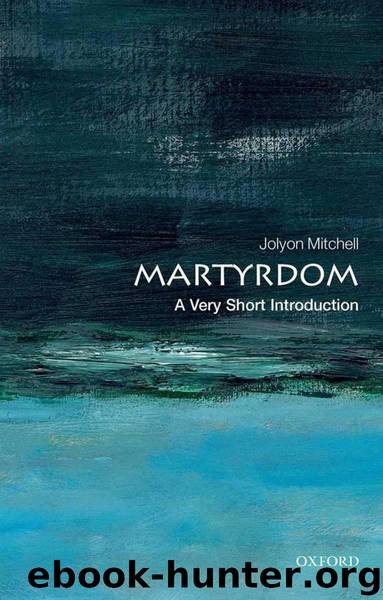Martyrdom: A Very Short Introduction (Very Short Introductions) by Jolyon Mitchell

Author:Jolyon Mitchell
Language: eng
Format: mobi, epub
Publisher: Oxford University Press
Published: 2012-11-28T16:00:00+00:00
Reforming martyrdom in historical context
King Henry VIII (1491–1547) bequeathed to his children a nation divided over religion. Henry had effectively made a declaration of independence from the pope’s authority in 1534, when parliament legislated that he was ‘supreme head’ of the English church. As a result he was free to annul his marriage to Catherine of Aragon (1485–1536) and marry Anne Boleyn (d.1536). Henry may have dissolved the monasteries (1536–41) and been excommunicated by Pope Paul III (1538), but he remained largely loyal to Catholic beliefs.
Following Henry’s death his 9-year-old son was crowned Edward VI (1537–53). Edward had been tutored in the ways of Protestantism. Under the direction of Archbishop Cranmer and several powerful nobles, the reformation from above accelerated during Edward VI’s reign (1547–53). Reformers like John Foxe saw Edward as a ‘godly prince’ in the mould of King Josiah, who had brought about religious reform in Israel (2 Kings 22–23; 2 Chronicles 34–35). Foxe joined members of the Protestant elite, who supported the ‘mass destruction’ of Catholic rituals.
Following Edward’s death his half-sister Mary (1516–58) took the reins of power (1553–8). A staunch Catholic, she initiated a radical turn back towards Catholicism. Hoping for a rapprochement with Rome, she was a driving force behind the persecution of reformers. Her opponents would come to call her ‘Bloody Mary’. England swung back to Catholicism and Foxe feared for his life. He escaped with his pregnant wife and joined other exiles in Strasbourg. Here, and later in Basel, he was in a ‘news hub’ for receiving and recording reports of martyrdoms from around Europe. After Mary’s death in 1558, and her half-sister Elizabeth’s (1533–1603) accession to the throne, John Foxe, like other reformers, returned to his native land. What he had begun writing in Latin as an exile he now continued in English as a returnee. Foxe would find, in Queen Elizabeth’s regime (1558–1603), fertile ground in which to sow his stories of martyrdom.
Download
Martyrdom: A Very Short Introduction (Very Short Introductions) by Jolyon Mitchell.epub
This site does not store any files on its server. We only index and link to content provided by other sites. Please contact the content providers to delete copyright contents if any and email us, we'll remove relevant links or contents immediately.
| Buddhism | Christianity |
| Ethnic & Tribal | General |
| Hinduism | Islam |
| Judaism | New Age, Mythology & Occult |
| Religion, Politics & State |
Cecilia; Or, Memoirs of an Heiress — Volume 1 by Fanny Burney(32446)
Cecilia; Or, Memoirs of an Heiress — Volume 2 by Fanny Burney(31875)
Cecilia; Or, Memoirs of an Heiress — Volume 3 by Fanny Burney(31861)
The Secret History by Donna Tartt(18866)
Sapiens: A Brief History of Humankind by Yuval Noah Harari(14259)
Leonardo da Vinci by Walter Isaacson(13190)
The Radium Girls by Kate Moore(11936)
Sapiens by Yuval Noah Harari(5298)
How Democracies Die by Steven Levitsky & Daniel Ziblatt(5135)
The Wind in My Hair by Masih Alinejad(5036)
Homo Deus: A Brief History of Tomorrow by Yuval Noah Harari(4829)
Endurance: Shackleton's Incredible Voyage by Alfred Lansing(4687)
The Silk Roads by Peter Frankopan(4462)
Man's Search for Meaning by Viktor Frankl(4440)
Millionaire: The Philanderer, Gambler, and Duelist Who Invented Modern Finance by Janet Gleeson(4387)
The Rape of Nanking by Iris Chang(4142)
Joan of Arc by Mary Gordon(4024)
The Motorcycle Diaries by Ernesto Che Guevara(4021)
Hitler in Los Angeles by Steven J. Ross(3902)
